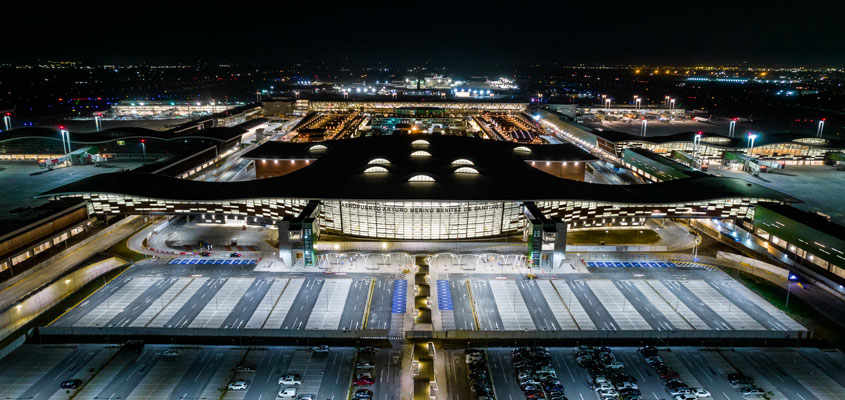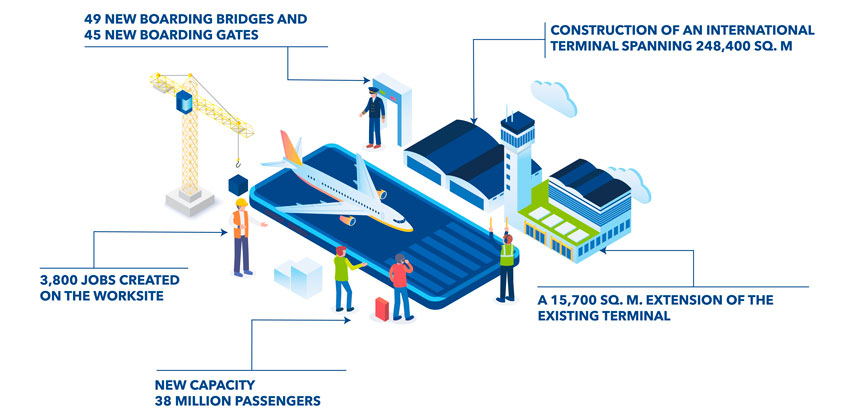Santiago airport in Chile - Looking back at the creation of a global air transport hub
23 March 2022 - Events - Chile
The new Santiago International Airport in Chile, recently inaugurated, is the result of a vast modernisation programme launched by VINCI Airports on award of the concession. We look back at this extraordinary five-year project that illustrates the effectiveness of the Group’s integrated model.
Operator of the Santiago airport since 2016, Nuevo Pudahuel, a joint venture in which VINCI Airports and the ADP Group have a majority share, won the concession by responding to very ambitious specifications. They involved delivering an in-depth transformation of this infrastructure, which is crucial to Chile’s economic development. The country has experienced rapid growth since its return to democracy, with a five-fold increase in GDP per capita - the highest in South America - between 1990 and 2015. However the airport failed to match this extraordinary growth spurt: lack of adequate investment over the years left it close to saturation in terms of its capacity to handle freight and passenger transport.
The many advantages of the Santiago airport
”Apart from Chile’s dynamism,” recalls the CEO de Nuevo Pudahuel, Xavier Lortat-Jacob, “we decided to get involved in this concession because of the airport’s intrinsic quality: it was already the sixth-largest on the continent, the country’s only international airport, at the heart of a region of 8 million inhabitants, served by two motorways and located just 30 minutes from the centre of Santiago.” The airport was also the base of Latam, the main South-American airline company.The potential was undeniably there. All that remained was to tackle the project with the appropriate means and expertise. VINCI Airports set about doing this by launching a vast modernisation programme as soon as the concession came into force.
The concessions-construction duo at the controls of a major project
The project aimed to increase the airport’s capacity, from 16 to 38 million passengers a year. And it was VINCI’s integrated model that allowed it to take on this gigantic challenge, with VINCI Airports acting as project manager, while VINCI Construction Grands Projets headed up the construction consortium to launch one of the biggest building projects ever carried out by the Group outside France.The project stands out, first of all, for its scope: an investment of almost $1 billion, the largest made in concessions in Chile for over 20 years. It called for rehabilitating the old terminal, to be reserved for domestic flights, while at the same time extending its area, and building a new international terminal with its five main buildings and annexes. Before the foundation stone was laid in 2017, the input of the infrastructure’s final user, represented by VINCI Airports, was essential during the project design phase, making it possible to provide a precise configuration taking all technical systems into account, right down to baggage handling and the boarding bridges between terminals and aircraft. Nicolas Notebaert, CEO of VINCI Concessions and Chairman of VINCI Airports, sums up the project as follows: “It was an ideal terrain to deploy the Group’s integrated model: its potential could only be unlocked by mobilising, simultaneously, high investment capacity, specific airport know-how and cutting-edge expertise in construction and project management.”
All this while making sure not to disrupt airport operations, which continued during the project.
But this same complexity can also be found on the technical level. Chile, like Japan, is located on the famous Pacific Ring of Fire, and has one of the highest levels of seismic activity in the world. This factor requires the highest construction standards and imposes major constraints on builders.
Technology at the crossroads of the two businesses: BIM
Santiago was the first time VINCI Construction Grand Projets used full BIM (Building Information Modelling), a technology for modelling building data that is then used across the whole life cycle. This digital model is useful in the design-build process, since it centralises information, facilitating coordination and communication between the project players with whom it is shared. Another important advantage is that it provides visualisation of the entire project from the design phase. In the case of Santiago Airport, this allowed management of passenger flows and the constraints linked to airport security, but also decisions concerning the location of commercial spaces. The model is then delivered, at the same time as the completed infrastructure, to VINCI Airports as concession holder, which can use it to guarantee 100% digital management of operation and maintenance.
Subscribe
Media contacts
Stéphanie Malek
Tel: +33 1 57 98 66 28
media.relations@vinci.com


